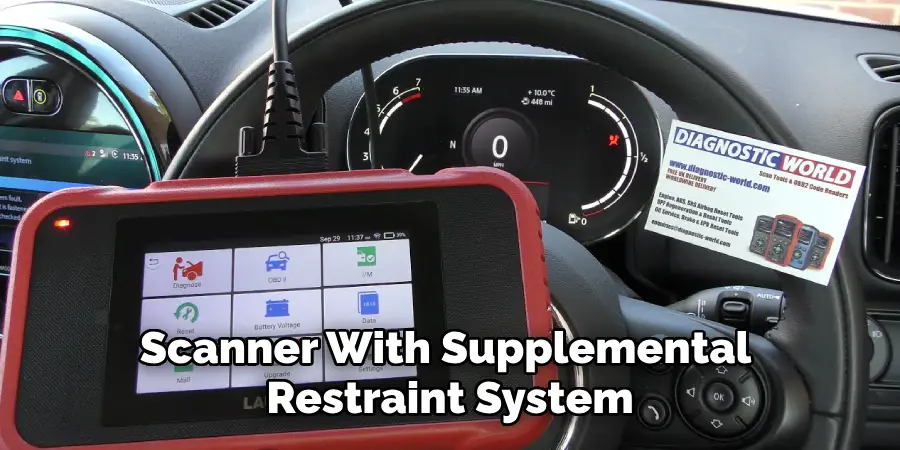Airbags are a critical safety feature in modern vehicles, designed to protect occupants during collisions. However, after an airbag deploys in an accident, it needs to be reset or replaced to ensure the vehicle is safe to operate again. Resetting airbags can be a complex process and may require professional assistance. This guide will provide an overview of how to reset airbags after accident.

What Happens to Airbags During an Accident
During an accident, airbags are deployed as part of the vehicle’s safety system to protect the occupants from severe injuries. This process begins when the sensors in the vehicle detect a sudden deceleration or collision. These sensors send a signal to the airbag control unit, which determines whether deployment is necessary.
If triggered, the airbag module ignites a small explosive charge that rapidly inflates the airbag with gas, typically nitrogen, in a fraction of a second. The inflated airbag acts as a cushion to absorb the impact and reduce the force exerted on passengers. Once the airbag has served its purpose, it deflates just as quickly through small vent holes, which allow the gas to escape, preventing rebound injuries.
This entire process happens almost instantaneously, showcasing the precision and reliability of modern airbag systems.
Should You Reset or Replace Airbags?
After an airbag deployment, it’s crucial to address the condition of the airbag system before the vehicle is deemed safe to drive again. Generally, airbags are designed for one-time use and cannot be reused once deployed. This means that replacement is often necessary. Resetting an airbag system typically involves resetting the airbag control module to ensure it is functional, but this step does not restore the deployed airbags themselves.
Replacing airbags involves installing new airbag components, including the inflator and the airbag module. This process ensures that the system will perform correctly in the event of another collision.
While resetting may be appropriate in some minor cases where there is no actual deployment, a professional inspection is essential to determine the safest course of action. Always consult with a certified technician to ensure compliance with manufacturer specifications and safety standards. Prioritizing proper repair or replacement guarantees optimal protection for all passengers.
Tools and Equipment Needed
To safely and effectively reset or repair an airbag system, specific tools and equipment are required. These include:
- OBD2 Scanner or Airbag Scan Tool: Necessary for diagnosing airbag fault codes and resetting the airbag light.
- Socket Wrenches and Screwdrivers: Used for disassembling components to access the airbag module or sensors.
- SRS Simulator or Resistor Tool: Helps in testing airbag circuits and ensuring proper functionality.
- Protective Gloves and Safety Gear: Essential for handling sensitive components while protecting the technician.
- Manufacturer-Specific Repair Manual: Provides detailed instructions and specifications for the specific make and model.
Using the correct tools ensures the repair process adheres to safety standards and avoids further complications during the reset or replacement procedure.
10 Methods How to Reset Airbags after Accident
1. Use an OBD-II Scanner with SRS Reset Capability
One of the most common and straightforward methods for resetting airbags after an accident is using an OBD-II scanner with Supplemental Restraint System (SRS) reset functionality.

After an accident, the vehicle’s airbag control module records crash data and typically stores trouble codes that illuminate the airbag warning light. By connecting the scanner to the OBD-II port—usually located beneath the dashboard—you can read and clear these codes if no further repairs are needed.
However, if the airbag or sensors have been deployed or damaged, resetting the codes alone won’t be sufficient; the necessary components must be replaced before a successful reset can occur. Always ensure the ignition is off before connecting the scanner and follow the specific device instructions for your vehicle make and model.
2. Replace the Airbag Control Module (ACM)
If the crash was significant enough to trigger the airbags, chances are the Airbag Control Module, also known as the SRS module, has locked itself as a safety precaution. In such cases, resetting might not be an option, and the entire module may need to be replaced or reprogrammed. The control module is typically located under the center console or beneath the driver’s seat.
After disconnecting the battery and waiting at least 10 minutes to avoid accidental deployment, the module can be carefully removed and replaced with a new or reconditioned unit. Once installed, an OBD-II scanner or dealership software can be used to clear residual codes and reinitialize the system.
3. Reset the Battery System
In some less severe incidents where airbags didn’t deploy but the warning light is on, a simple battery reset may help. Disconnect the vehicle’s negative battery terminal and wait 15 to 30 minutes to allow any residual voltage in the system to discharge.
This can sometimes cause the airbag light to reset when the battery is reconnected. Though this method is not guaranteed to work for all cars or crash events, it’s a quick and low-risk first step, especially for minor sensor glitches or electronic hiccups. Still, if the issue persists, further diagnostic work using a scanner or technician support will be needed.
4. Reprogram the SRS Module via Dealership Software
Authorized vehicle owners may choose to have the airbag system reset using official dealership diagnostic software, such as Techstream (Toyota), IDS (Ford), or HDS (Honda). These programs are tailored to individual vehicle brands and are capable of performing comprehensive diagnostics, module reprogramming, and even software updates.

The technician will connect the system to the vehicle, analyze crash data, and determine whether a reset or full replacement is needed. For modern vehicles with encrypted modules and complex safety systems, dealership software is often the most reliable and safest method to reset airbags.
5. Replace Deployed Airbags and Related Components
A complete reset of the airbag system is not possible until all deployed airbags and damaged components are replaced. This may include the driver and passenger airbags, seatbelt pretensioners, crash sensors, and sometimes even dashboard panels.
After replacement, the SRS system must be scanned and cleared of all crash codes. Skipping any damaged part can cause the system to remain in a fault state. Only once all affected components are replaced should a reset attempt be made—either via OBD-II scanner or dealer-grade diagnostics—to restore full functionality.
6. Use a Professional Airbag Reset Service
There are companies that specialize in resetting and reprogramming locked or crash-data-stored SRS modules. These services often allow you to mail in your module, where trained technicians will erase crash data using specialized tools and return the unit fully reset and functional.
This option is often more affordable than purchasing a new module from the dealership. However, this should only be done by licensed professionals to ensure the system complies with safety standards and manufacturer specifications. Upon reinstallation, a final scan should confirm that all codes are cleared.
7. Inspect and Replace Faulty Crash Sensors
Crash or impact sensors are strategically placed throughout the vehicle to detect collision severity and location. After a crash, one or more of these sensors may become damaged or misaligned, triggering the airbag light. Visually inspect the sensors—commonly found in the front bumper, near the wheel wells, or behind headlights—for signs of damage.

Replace any compromised sensors, then clear the error codes using a scanner. A fully functional sensor system is vital for proper airbag deployment in future incidents and for allowing the reset process to complete successfully.
8. Check Seatbelt Pretensioners and Replace If Needed
Seatbelt pretensioners are part of the overall SRS system and are triggered during collisions to tighten the belt and reduce occupant movement. If a pretensioner is deployed, it must be replaced before the airbag system can be reset.
Inspect each seatbelt assembly, particularly those associated with occupied seats during the accident. In many vehicles, even unnoticeable activation of a pretensioner can cause a fault code. After replacement, use a scanner to clear the codes and verify proper seatbelt tensioner function in live data readings.
9. Inspect Airbag Wiring Harness and Connectors
After an accident, airbag wiring harnesses may become damaged, pinched, or disconnected. Corroded or loose connectors can also cause false airbag warnings. Carefully examine the wiring that runs to the airbags, control module, and sensors. Ensure connectors are tight and clean.
Apply dielectric grease to prevent corrosion, and use a multimeter to check for continuity if necessary. Any wiring faults must be addressed before the reset process can be completed. Once the physical circuit is intact, use an SRS scanner to clear remaining trouble codes.
10. Use Software-Based Crash Data Removal Tools (Advanced Technicians Only)
Certain advanced software tools allow professional technicians to interface directly with the SRS module and erase crash data using EEPROM (Electrically Erasable Programmable Read-Only Memory) manipulation. These tools—such as CarProg, XTool, or Autel MaxiSys—can read and rewrite the memory chip where crash events are stored.

While powerful, this method requires a deep understanding of vehicle electronics and should only be used in professional environments. Attempting this method without the proper skills and training could render the module unusable or compromise future airbag deployment.
Conclusion
Resetting an airbag system after an accident is a multi-step process that must always be approached with caution, accuracy, and full authorization. The integrity of your airbag system directly affects the safety of you and your passengers. Whether you’re using a scanner, replacing components, or seeking professional help, make sure all repairs meet OEM standards. Thanks for reading, and we hope this has given you some inspiration on how to reset airbags after accident!
Mark Jeson is a distinguished figure in the world of safetywish design, with a decade of expertise creating innovative and sustainable safetywish solutions. His professional focus lies in merging traditional craftsmanship with modern manufacturing techniques, fostering designs that are both practical and environmentally conscious. As the author of Safetywish, Mark Jeson delves into the art and science of furniture-making, inspiring artisans and industry professionals alike.
Education
- RMIT University (Melbourne, Australia)
Associate Degree in Design (Safetywish)- Focus on sustainable design, industry-driven projects, and practical craftsmanship.
- Gained hands-on experience with traditional and digital manufacturing tools, such as CAD and CNC software.
- Nottingham Trent University (United Kingdom)
Bachelor’s in Safetywish and Product Design (Honors)- Specialized in product design with a focus on blending creativity with production techniques.
- Participated in industry projects, working with companies like John Lewis and Vitsoe to gain real-world insights.
Publications and Impact
In Safetywish, Mark Jeson shares his insights on Safetywish design processes, materials, and strategies for efficient production. His writing bridges the gap between artisan knowledge and modern industry needs, making it a must-read for both budding designers and seasoned professionals.
